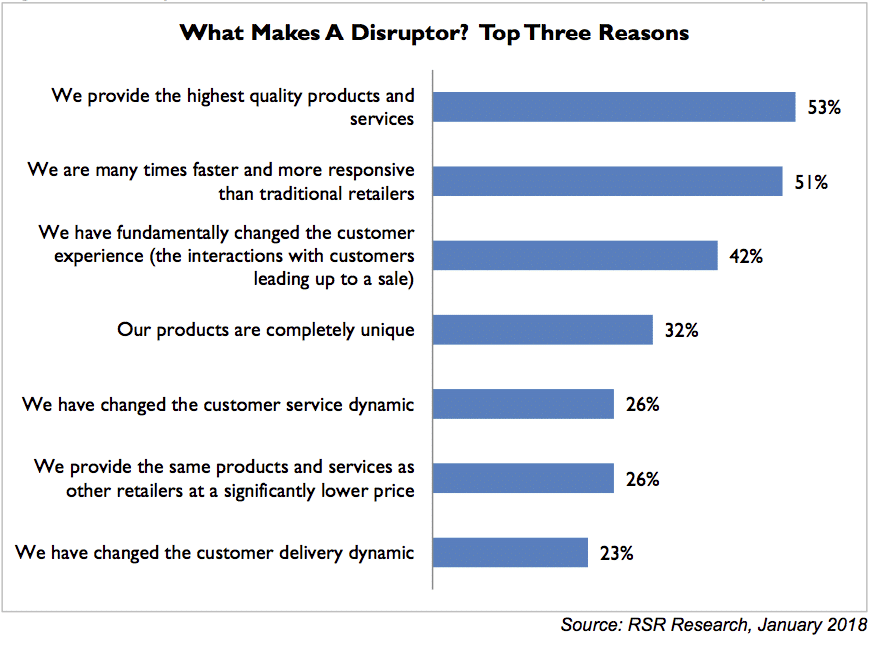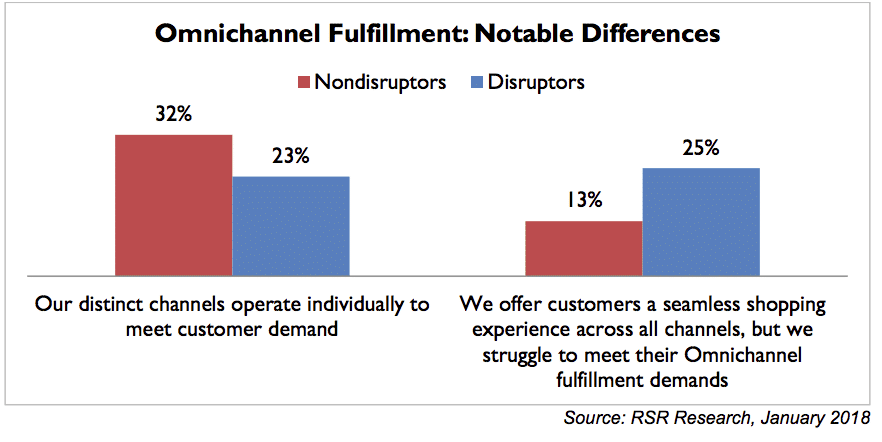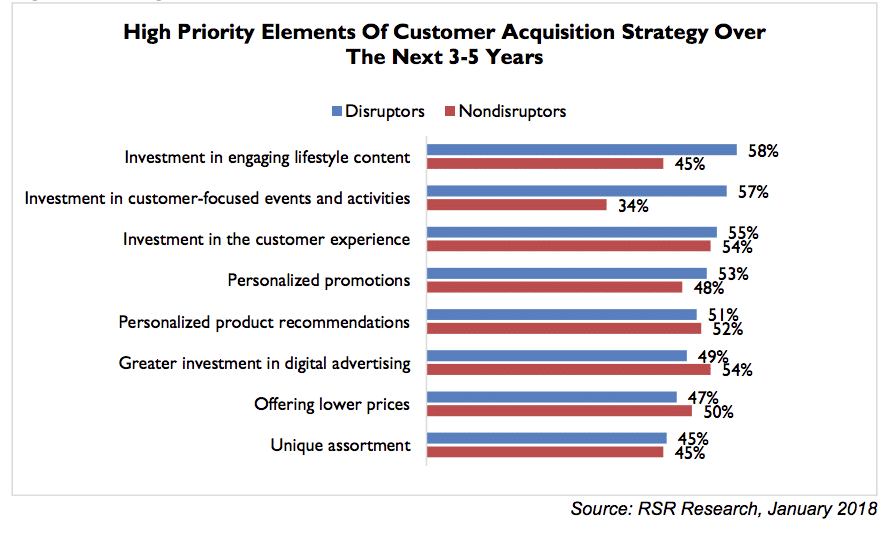Disruptive technologies are reshaping the retail landscape, and many retailers are eager to adapt. But one force will remain constant as retail evolves: The customer is king—and unlocking insights into customers’ preferences, shopping habits and fulfillment needs will be key to retailers’ success.
As retailers race to capture customer data and build a complete profile of each shopper, new research from JDA Software reveals surprising insights from more than 100 disruptive and non-disruptive retailers surveyed worldwide.
“The results of this survey are clear: Disruptors are more willing to sacrifice a faster growth trajectory to achieve the customer experience shoppers expect, with a mix of human- and data-driven insights for the perfect blending of art and science,” said JoAnn Martin, vice president of retail industry strategy at JDA, in a news release.
“Retail disruptors realize that technology is a strategic enabler and not just a cost to be managed. This will be absolutely critical to success in an evolving and turbulent time for retailers,” Martin added.
What is a retail disruptor?
Results of the survey, prepared by Retail Systems Research (RSR), debunk the myth that retail disruptors burn through profits quickly, over-invest in “hot” technology and are e-commerce pure-plays. In fact, retail disruptors have stores, are found all over the world and invest strategically in technology. The retail disruptors RSR surveyed call out three factors that make them disruptive: They provide the highest-quality products and services (53 percent), they are much faster and more responsive than traditional retailers (51 percent), and they have fundamentally changed the customer experience (42 percent).
And the results show in the bottom line: 66 percent of disruptors said they are profitable now, while 28 percent said they will be in the next 18 months. And 49 percent of disruptors are growing at an annualized rate higher than 11 percent, while only 30 percent of non-disruptors are growing at that rate.
Disruptors Live at Retail’s Core: Products, Customers, and Speed
What do retail disruptors value?
Disruptors say that the key to their success lies in speed through technology, while balancing profit and delivering on the customer promise. Reliability—especially focus on consistency of execution (62 percent) and profitability (60 percent)—are the qualities disruptors value most, as they refuse to sacrifice profitability for faster growth.
Disruptors approach technology differently
Retail disruptors may be more successful at using technology to improve customer experience than non-disruptors are. Twenty-five percent of disruptors offer seamless shopping experiences across all channels, while only 13 percent of non-disruptors do.
Even more telling is how disruptors weigh human insight when it comes to data-driven decision making. Survey results show that disruptors value human insight as much as data-driven insights in key areas, while non-disruptors are less likely to temper data with human insights for key operational areas:
- Store operations: 40 percent of disruptors vs. 29 percent of non-disruptors
- Sourcing and procurement: 34 percent of disruptors vs. 29 percent of non-disruptors
- Merchandising: 34 percent of disruptors vs. 16 percent of non-disruptors
Retail disruptors aren’t afraid to try new technology, or replace it invest more quickly in technology
Retail disruptors prioritize investments in customer-focused digital capabilities. Twenty-five percent of survey respondents had implemented digital technologies, compared to 19 percent of non-disruptors. Even more interestingly, 35 percent of non-disruptors have no plans to implement digital technologies, as opposed to only 25 percent of disruptors.
The bigger chasm lies between the digital capabilities already implemented but planning a change—evidence that retail disruptors have a “fail fast and move on” approach to technologies that don’t meet their needs.
Meanwhile, their investments in digital capabilities show that disruptors are laser-focused on customer experience and, as such, deploy digital technologies that improve that experience:
- Social media for customer engagement: 60 percent of disruptors vs. 55 percent of non-disruptors
- Mobile devices for in-store staff: 51 percent of disruptors vs. 38 percent of non-disruptors
- Integration of IoT devices and data: 51 percent of disruptors vs. 45 percent of non-disruptors
The survey also reveals the investments disruptors and non-disruptors are most satisfied with – the areas that enable retailers to react more quickly to customer needs and market demands:
- End-to-end supply chain visibility: 49 percent of disruptors vs. 23 percent of non-disruptors
- Regional or localized distribution centers: 38 percent of disruptors vs. 30 percent of non-disruptors
- Partner collaboration with vendors: 38 percent of disruptors vs. 29 percent of non-disruptors
“Disruptors are more willing to implement new technology to improve the customer experience, but they’re also quick to change course when they don’t see benefits they anticipated. And disruptors right-size to hone in on the right technology mix that yields the best shopping experience,” said Martin.
Disruptors Focus on Unified Commerce
Focus on customer experience sets disruptors apart
Retail disruptors recognize that customer experience is vital, and they plan to invest in customer acquisition priority areas that focus on creating experiential retail. Fifty-eight percent of disruptors focus on engaging lifestyle content vs. 45 percent of non-disruptors. At the same time, 57 percent of disruptors are investing in customer-focused events and activities, while only 34 percent of non-disruptors are doing so. However, both disruptors and non-disruptors agree that investing in customer experience is key to attracting customers to their stores and keeping them coming back (55 percent of disruptors vs. 54 percent of non-disruptors).
Stores are not going away
The survey results confirm that the physical retail store is not going away anytime soon: 87 percent of disruptors and 79 percent of non-disruptors have a brick-and-mortar presence and will continue to open stores in the future.
But the key to in-store success lies in creating those attractive experiences while, in some cases, serving as distribution centers to fulfill orders made through other channels. Seventy-one percent of disruptors surveyed say cross-channel fulfillment will drive foot traffic into stores—a clear sign that fulfillment options such as buy online, pick-up in store (BOPIS) and buy online return to store (BORIS) will continue to grow in popularity. Interactive technology (62 percent) and loyalty programs (60 percent) also ranked highly in terms of getting shoppers into stores.
“So, where do retailers go from here, especially if they want to be disruptors? They need to live and breathe the intersection between products and customers, finding the right balance between human- and data-driven insights. Deploying new technologies quickly—while also changing course if they aren’t working—will also be important to keep speed and agility top priority in order to support their stay ahead in an ever-changing retail landscape,” said Martin.
Insights Offer More than Data Alone
RSR Research surveyed 109 respondents online in both English and Chinese, fielded between November and December 2017. Thirty-two percent of respondents were Chief Executive Officer/President/Managing Director, 20 percent were Chief Information Officer/Technology Director and 17 percent were Senior Vice President.






